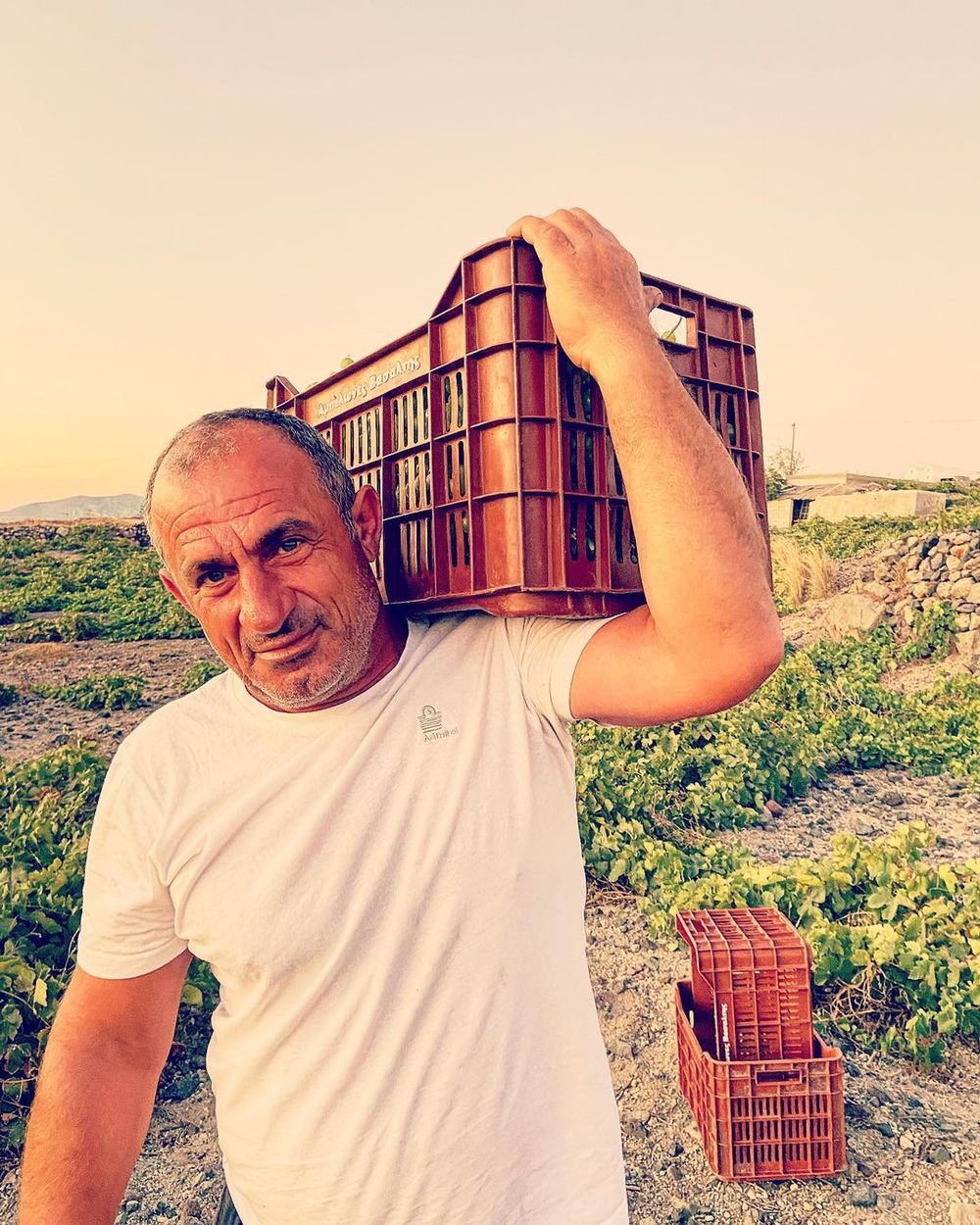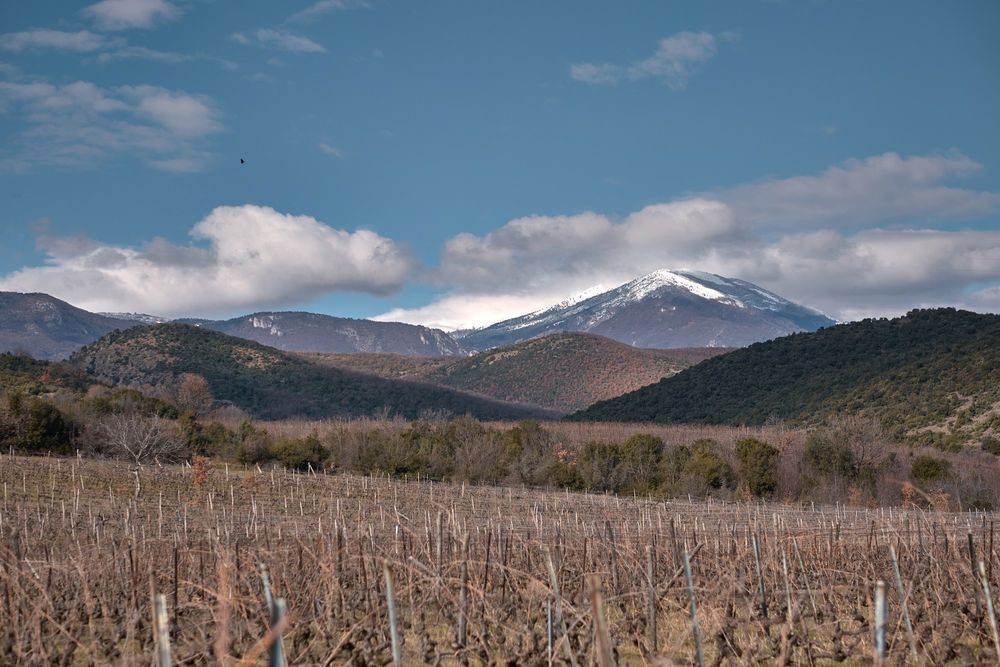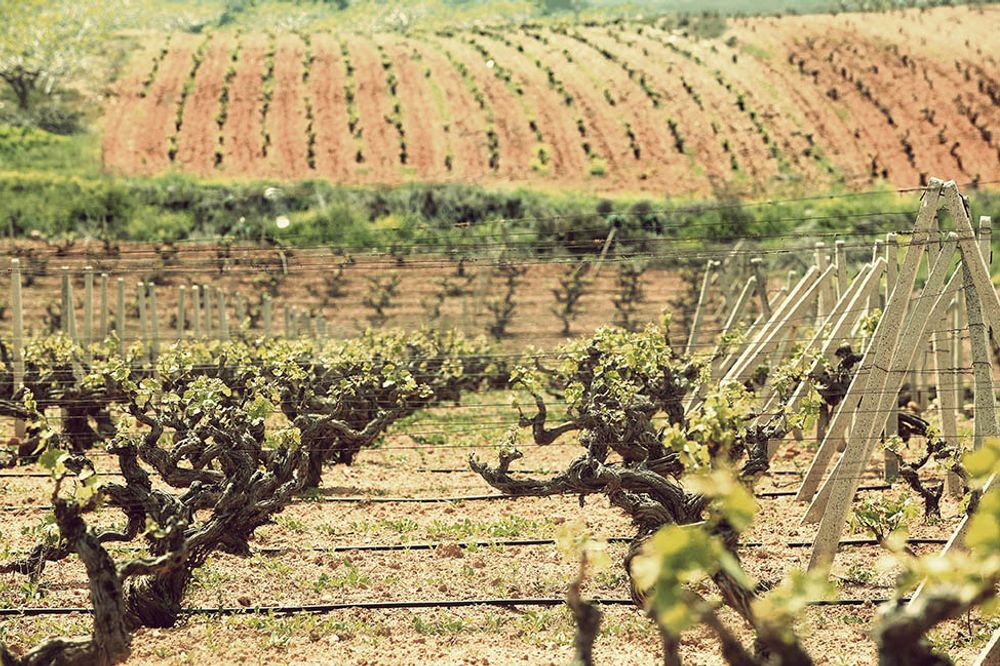“Whites lead the way but reds are on the same trajectory. In ten years time we’re going to see some really interesting wines made not just from Agiorgitiko and Xinomavro, but lesser known varieties,” says Steve Daniel.
I’m old enough, sadly, to remember the days when mere mention of Greek wine would invite sniggers and references to Retchina and Demestos – “the wine that kills all known germs dead”.
Those days are long gone. Greek wine today has something akin to hero status, with somms, wine critics and others all loving the points of difference that make many of the wines from this stunning country unique. Producers, encouraged to boost exports after the 2008 economic crisis, have become quality focused and strongly committed to indigenous varieties, all things that resonate with the quality on-trade.

Apostolos Thymiopoulos producing 10 different expressions of xinomavro
But how have sales fared in this bastard of a year?
“Hospitality is down of course and exports to this country were never high but interest remains very high. And the trick is to translate that into sales. But people are recognising that there is a value, excitement and diversity in Greece that you don’t find in many other wine-producing countries,” says Maria Moutsou, founder of specialist wine importer Southern Wine Roads (SWR).
Steve Daniel, wine buyer for HN Wines, dates his own Greek wine epiphany back to student days in Mykonos in the 1980s drinking, um… Retsina and Demestica. He says it’s been a long but wonderful road from then, when Greek wine was dominated by big producers like Tsantali, Achaia Clauss and Boutari. He argues that today’s industry is very modern, enabled by technological innovation (and EU grants) but with its feet firmly in the past, as winemakers resurrect old traditions and varieties.

Steve Daniel – long-standing champion of Greek wine
“Whites lead the way but reds are on the same trajectory. In ten years time we’re going to see some really interesting wines made not just from Agiorgitiko and Xinomavro, but lesser known varieties,” he says.
But if 2020 has taught us anything it’s that time can be fickle and it’s best to enjoy what today has to offer. So in that spirit, here’s a partial A-X of why we should embrace Greek wine right now.

Last day of harvest 2020 at Vassaltis
Assyrtiko is everyone’s first ‘go to’ Greek variety and the saline, citrusy wines made so famously in volcanic Santorini’s famous basket vines have rightly captured people’s hearts, or palates. But, although the number of producers there now tops 20, land prices and thus wine prices have rocketed. So it’s just as well producers are growing it in other parts of Greece – most notably in Crete and Tinos but elsewhere too.
Southern Wine Roads has two opposite-ends-of-the-spectrum examples, a rounded, perfumed full bodied on-lees 2018 example from Vriniotis, with spontaneous fermentation and natural yeasts giving added authenticity; and a 100% organic, natural 2019 wine from Kontozisis Vineyards. Made in the mountainous terroir of southeast Thessaly – the Uncharted Mountain range – this is delicious, tiny volume but pure unadorned Assyrtiko.
For a more mainstream but equally appealing Assyrtiko, Domaine Papagiannakos in Attica – around 40 kilometres from Athens – is well worth trying; the 2018 is characterised by tropical fruits and delicate white blossom, with a long finish. (Boutinot).
But for those who insist on Santorini, look no further than Vassaltis. One of the region’s newer producers, established in 2014 by Yiannis Valabous, who left a London-based career to take over plots owned by his father. His winemakers are already making an ambitious range of high end, handcrafted wines, including the straightforward Vassaltis 2018, left on the lees for six months in stainless steel to produce a delicious, full-bodied herbily aromatic wine. The barrel-aged 2018, which starts life in the tank, moves to barrel for six months, then back to tank before spending another eight months in bottle, is a complex, layered wine which probably needs more time to show at its best. The stunning, saline, herb-driven Cuvee des Vignerons 2017 is long-fermented in stainless steel before spending a year on the lees and a further seven months in bottle. Again, amazingly rich and powerful, showing how far this producer has come in just six years. Assyrtiko at its best (Flint Wines).

Benchmark producers are key to any wine region’s transformation and Greece now has these in growing profusion. Long established names like Thymiopoulos and Dalamara – both famed for their Xinomavro – have been joined by the likes of Gaia Wines in Santorini/Nemea, Lyrarakis in Crete, Alpha Estate in Amyndeon, Ktima Biblia Chora in Kavala and Ktima Gerovassilou in Epanomi. With 1300 producers now active in Greece, expect more to come. Obvs.

Xinomavro – one of the hits of 2020
Indigenous varieties are, frankly, the main raison d’etre of emerging regions and with 250-300 on the mainland and islands, Greece has many. Adventurous producers are resurrecting varieties long thought extinct, or near extinct whilst also working more carefully with other local varieties, to ensure they better reflect their natural sense of place. Although there are some great red varieties to look out – Limnio, Mavrotragano and Liatiko, to name just three – whites are where the action is right now, with old workhorse grapes like Savatiano (used for retsina and the country’s most widely planted grape) and pink-tinged Roditis getting a quality makeover. Varieties definitely worth trying are laurel-flavoured Dafni from Crete, Vidiano from the same island, the delicious, rounded Viognier-like Malagousia from northern Greece (rescued from obscurity by Vangelis Gerovassiliou) and the soft, aromatic moreish Moschofilero, with a PDO just south of Nemea.

Downtime for assyrtiko vines on Santorini
Natural/biodynamic/organic wine is commonplace in Greece not just because it sells well in markets like the UK but because, frankly, it’s produced more easily here than in most places.
“Greek wines were traditionally always low intervention; this only changed in the 1960s with industrialisation and tourism. But memories haven’t faded and winemakers are returning to the practices of their fathers and grandfathers, enabled by the natural conditions here, including the terrain, the dryness and lack of disease,” says Southern Wine Roads’ Maria Moutsou.

Retsina, once Greece’s calling card,has had a makeover. Kourtaki (now part of Greek Wine Cellars) still makes the heavily pine-resinated wine that will bring back those youthful holiday memories, but other producers are being more adventurous, with Pet Nat Retsina amongst the style to be tried. Southern Wine Roads has two very different examples: Botanic Brut, by Nikolou Winery, is made in the champagne style with wild flowers, yeasty mineral and herbal flavours on the palate. More mainstream is the delicious, long 2015 wine from Aoton Winery in Attika, tiny in volume but big on flavour, the pine resin perfectly balanced by fruit and acidity. Retsina, but not as we know it.

Terroir is key to what makes Greek wine so distinctive: the island and mainland terrains can be so different that it is little wonder that wine styles and varieties vary so dramatically.
“Greek terroirs are exciting but they are also unique, ancient and impossible to replicate: that is why wines from say, Santorini are so fundamentally different from those from Ikaria, whilst Lesbos, famous for the almost extinct Chidioriotiko, is again another world,” says Moutsou.

Nemea in the Peleponnese, is Greece’s largest PDO and your first port of call for Greek reds. It is best known for Agiorgitiko, or the St George grape, a classically Mediterranean variety which generally gives big full-bodied wines. The organic Fysis 2016 (‘fysis’ means ‘nature’ in Greek) produced by Athanasiou winery is a wonderfully rich, full-on example, lots of red and dark fruit balanced by firm acidity. Even bigger is the Nemea Aivalis 2014, very jammy, oak aged for a year with full-on dark berry flavours, leavened with a pleasant smokiness. (Both Southern Wine Roads).

Variety, excitement and value in Greek wine – Maria Moutsou
Value is becoming easier to find despite Greek wines being generally small volume and high cost. It would be hard to find a better value red than Thymiopoulos’s Jeunes Vignes Xinomavro, around £11 from the Wine Society: light but not excessively so, lightly perfumed red fruits, un-oaked, so serve lightly chilled. For a little more Kontozisis Vineyards Drop by Drop The Jar Fills Up 2019 from Karditsa, Thessaly is a wonderfully mineral-driven organic white, almost disturbingly more-ish. (Southern Wine Roads).
And Notios, the Peloponnese range from Gaia, offers exceptional value for £12-15: the red 2019 is a warm, brambly moreish blend of 85% Agiorgitiko and 15% Syrah, held together with soft velvet tannins. Even better is the 2019 white, a blend of Moschofilero, Roditis and Assyrtiko, each variety adding something substantial (the Moschofilero rounded, floral flavours and the Assyrtiko, zest and acidity). Quite delicious (HN Wines).
At £8.95, the Wine Society’s first own label Greek wine, a white blend of Moschofilero and Roditis, made by Semeli in Nemea, is almost indecently cheap but offers lots of honeysuckle aromatics, with peach, apricot and grapefruit on the palate. Summer in a bottle. (Wine Society)

Xinomavro is the red Greek variety on everyone’s lips, and little wonder. It is often described as this country’s answer to Nebbiolo, capable of making ageworthy wines with firmness, bite and acidity. But that somehow doesn’t do justice to a variety that just ten years ago was so unfashionable in the five regions of Naoussa where it grows best that vines were being grubbed up.
“Xinomavro has the widest flavour profile of any variety I have tasted. Structure and tannins make this an absolutely fascinating grape”, says Southern Wine Roads’ Maria Moutsou.
Start with Thymiopoulos and Dalamara and explore from there.

As 2021 dawns, there are already signs the on-trade – and the off-trade too – are taking a greater interest in Greek wine. Flint Wines have just taken on Vassaltis Wines from Santorini, with other wines soon to be added to the Assyrtikos already listed.
“The Greek wine scene has been on our radar for a while now. The unique styles and interesting indigenous grape varieties make Greece one of the world’s most compelling wine-producing countries. We felt it was the perfect time to get involved in this exciting, modern revolution,” says Gearoid Devaney MS, Flint Wines’ director of trade sales.
And Greek specialists Cava Spiliadis has just added two tiny-volume wines made from local varieties on Tinos by Christos Fonsos to their already extensive list, with more to follow in 2021. The wines – Mathiulis White and Red – are very distinctive, made from grapes grown on pre-phylloxera vines; the producer makes just 3500 bottles in total. Amongst the other wines listed by Cava Spiliadis include two moreish sparkling wines from producer Tselepos in the Peloponnese made from local varieties Agiorgitiko and Moschofilero.
Steve Daniel says that “perhaps the best thing about Greek wine is that it is just going to get better.”
I’d agree.
And there aren’t many things you can say that about right now.
Wines available from SWR, Cava Spiliadis, HN Wines, Flint Wines, Wine Society, Boutinot.





































